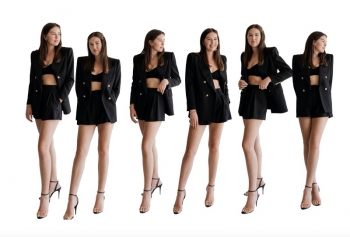Art In Interiors With Culture
Art in interiors can be a form of self-expression, but when it comes to choosing art for your home it can be confusing. Where do you start?
To the rescue to make the process interesting and never intimidating is Judy Brower Fancher of Brower, Miller & Cole, Interiors With Culture.
Brower, formerly a marketing executive who recently sold her successful agency, has traveled all over the world for decades acquiring art and getting to know artists and gallery owners.
Now she’s bringing her skills, love of international cultures, design, and contemporary art to clients who want access to original art in a process that’s stress-free and fun. She’s skilled at helping clients from first-time art buyers to those that may just be adding a piece to their existing collection.
Her company sources artwork for both residential and commercial spaces. She has a unique perspective as both an art collector and a certified interior designer, in that she’s able to understand how art works visually within her clients’ current designs.
1. How did you first get interested in the art world?
I’ve been passionate about art my whole life. I’ve been reading art books and going to art museums since childhood. I also took courses where I was able to make leather belts, movies, silver jewelry, paintings, ceramics, and even do large glassblowing. In college, I chose so many art history courses as elective classes out of sheer joy for the topic, that it resulted in a minor in art history.
I acquired my first “important” artwork at a charity auction when I was 24. It was very exciting to me, as art acquisition should always be! I still have it and although it is just a signed serigraph, it is now valued at double the price I paid.
2. When you first meet with residential clients, what is the first thing you do to decide what types of art would be best for their space?
Because art is personal, we begin with a fun conversation about other things they are passionate about, from family to cultural heritage, to favorite travel destinations, to hobbies they enjoy. The art in your home should make you feel whole and welcomed into your personal space.
We also talk about their interior design aesthetic, as the goal is to find art that will make their home cohesive in its design, as well as making it unique to reflect their individuality. While we all seem to like a white kitchen, it doesn’t mean that our homes should all really look the same. Art can be that transformational, compelling difference that makes your home really reflect you!
3. What makes your company unique?
We are not a gallery, nor do I represent specific artists that I am “pushing” on people.
This was a conscious decision I made to ensure that I am truly an art consultant that finds artwork that my clients want, rather than owning items I’m trying to sell them.
Having launched this firm as my passion career, I am truly committed to helping others find the joy and exhilaration that good art can bring to their home, their family,and their guests. I am working to improve my clients’ lives, one artwork at a time!
4. What advice do you have for collectors just starting to buy art for their homes?
The key is to find art you love. Art should feel really personal and frankly, emotional. That often takes time.
Most people have some items they are “okay with” that can fill the walls until the new collector has pieces they love. While art doesn’t have to be needlessly expensive, it’s kind of a shame to purchase items that are boring, even inexpensively, just to fill the walls.
I advise that they select one or two pieces at a time and then we can come back and find more. Room by room is often a good way to go, as the art pieces in each room should speak to one another. In addition, art that’s in the more public spaces is typically a different emotion than one wants to evoke in the private areas of the home.
5. What are some mistakes people make when they choose art for their homes, and what do you do to avoid mistakes?
I want to say this gently. Right now, there’s a sort of trend to buy what I call color Xeroxes, which are art pieces that are mass-produced. These can come from home stores or from interior design trade-only markets. The process used results in flat work. No texture, no light, and no individuality.
The challenge is they are devoid of emotion. Most are colors to match the couch. Many are so wrong for this area’s luxury design aesthetic that it’s like having metal folding chairs around your lovely dining room table. It simply doesn’t go with the home. And it certainly doesn’t make the owner, or their guests, swoon each time they see it.
6. Describe your dream project?
My dream project would be to do all the art for a Frank Lloyd Wright home. The ability to select art within architecturally compelling settings, where I’d have the opportunity to make a statement by juxtaposing period architecture with contemporary art, would be fantastic. I also like doing work that can be seen by many people, such as homes here in Southern California in which the owners often hold charity events and large parties. Good art is inspiring and it's best when it’s shared with a lot of people.
7. Do you also work with commissioned art?
Yes. Commissioned art is wonderful if you work well with the artist. By that, I mean that I find the vision for the piece, and most particularly, the perfect size for where it will be installed, and then let the artist be an artist. Most artists are willing to do commissions if they still have creative freedom.
If the piece is directed specifically by the buyer, the artists correctly feel they’re being used as tools, rather than respected as creators. I would never ask that of an artist, and I don’t believe the result would be positive. Artists need the space to put themselves into a piece in order to get a vibrant result.
8. Where do you get inspiration for what you do?
In the last 90 days, I’ve been to art galleries in Paris, Santorini and Mykonos, to art shows meeting artists from across the United States in Louisville, Indio, Palm Springs, Dallas and Newport Beach, as well as enjoying dinner with an artist who creates physically enormous artwork from his studio in Napa.
This week I’m visiting with galleries and artists in Laguna Beach, and next month I’m attending an art show in Los Angeles and meeting with galleries, art students and muralists in the greater Seattle area. This Spring, I’ll be seeing art in San Francisco and Mexico. With all this art in mind, my search for pieces that match what my Client is seeking becomes much more natural.
9. What makes you the happiest with your work?
While I truly loved my first career and am great friends with former clients and colleagues, in this realm I can’t believe how much fun it is to talk with and work with the creative people in the art world, surrounded by terrific art! I also adore traveling the country and the world to see art and meet artists.
10. What do you have to consider when choosing art?
On commercial projects, the focus is on finding work that respects the culture of the project and the history of the location, as well as ensuring that the wall art and sculpture will be appreciated by the client’s target audience of visitors, residents and/or employees.
For private clients, it’s all about reflecting on who they are and what they enjoy.
In both cases, I of course need to be mindful of the budget, the existing or planned design aesthetic, and the spaces in which the art will have the most impact.
11. Tell me about your commercial projects, how does that work?
Commercial art is needed for a variety of product types, from multifamily communities to hotels, to corporate lobbies or offices, to senior living communities, to retail spaces. And just because it is on behalf of a commercial client, that doesn’t mean that the art should be any less compelling. In fact, very specific bottom-line objectives, such as lease-up, retention, and brand building are key. In addition, attention to diversity and inclusion are very important both in the artists selected, and in the subject matter.
For commercial projects, my job, in addition to the items mentioned above, has very specific deadlines. There may be a nice window of time for my research and the client’s review and approval, yet there is a much more precise deadline for when the artwork needs to be delivered and installed. It’s not okay to be too early, just as it is not okay to be late. There’s a negative impact on the client if they have to store the art because the project isn’t ready for it. If the installation is a process in itself, I need to be mindful of the interior and landscape designers’ schedules so that the installation is planned into those schedules and flows smoothly.
12. What does art do for a multifamily community?
In a multifamily community, the art reflects the brand, the quality, and the attention of the owner, as well as meeting the taste of the targeted prospective tenants.
The art will help with lease-up, with retention, as well as ensuring that the property is respected and therefore treated well by its residents. Eventually, strong art will help with the sale of the asset. Prospective investors will feel the same quality, brand consistency, and pride of ownership that the residents find appealing.
In multifamily communities, this creates a dual ROI. First in leasing and retention and then again in asset value for the sale. Buy it once, love it twice!!
13. Are you mostly working in Orange County, or are you traveling to meet clients?
On the residential side, we’ve all learned that design can be done through remote technology. However, when the Client is in Southern California, I will meet them at their home. When they are outside the state, unless they ask me to fly to them, I use Zoom or FaceTime to “see” their space.
On the commercial side, my current project is in the state of Washington, and I am completely flexible to travel wherever the work is needed. Also, with commercial projects, the interior and landscape designs are typically available with floorplans, 3D renderings, color schedules, plant materials, etc. Those resources make any remote work especially easy.
The reason I want to go in person on the residential side is to get to know the Client as a true individual. On the commercial side, an in-person visit allows me to gain firsthand knowledge of the vibe of the community as to its economic, cultural and social lifestyle.
Think about it – if you just looked at photos, you might conclude that the Florida coast is all the same. Yet if you visit, you will find that Miami and Tampa are two very different places, each with its own wonderful and quite distinct aesthetic!
14. For clients on a budget, what’s the one thing they should splurge on when it comes to art?
True love. Acquiring one piece that holds a special place in the Client’s heart and in their home will be worth the splurge. In other areas, a Client can use mirrors, textural wall hangings, and personal photography that’s well-framed to create a strong overall design. Then over time, perhaps they acquire additional pieces that they love.
Moving the art one already owns to a new place in the home creates an entirely new look for the room! Even if a Client has an existing art collection, they may enjoy freshening the look by rotating their art with or without a new piece or pieces in the mix!
15. Lighting is so important when it comes to art, do you also assist with lighting?
Yes, the lighting can be a major asset. Because I find that people do enjoy changing their art, we often recommend modern track lighting which can be redirected based on the art hanging at that time, rather than a ceiling spot customized to one particular piece.
However, if desired, we can use a frame light to show the piece with good lighting that is mobile with the piece when it’s moved to a new location within the home or to a new home altogether. Unlike countertops, your art can come with you from one residence to another.
16. Are you also involved in the framing process when it comes to original art?
Absolutely. The frame can often make a great piece even better, and frankly the wrong frame can have the opposite effect. Selecting a frame can be a thoughtful process based on the time period of the art, the size of the art, the colors in the piece, and its place amongst other art.
While some pieces do come framed, not all are framed the way the Client would like. If the piece is being shipped, it is much more expensive, and fragile, to crate and ship it, than if it is unframed and can literally and safely be rolled up inside a tube.
Framing is really an art of its own. One can purposely frame a modern piece with a traditional frame to give it a fun juxtaposition, or vice versa. The size of the piece also gives a clue as to the optimal size of the matting and the frame.
I don’t recommend matching frames in a room except in certain situations in which one is creating a geometric gallery. Otherwise, if all the frames are alike, it will be too similar to having matching couches and chairs, which in most cases today is a bit of a faux pas. One also really wants the collection to look as though it was created over time. Matching frames don’t do that.
17. Do you have any pet peeves when it comes to art?
As I noted, the idea of mass-produced art in an otherwise lovely home is heartbreaking to me. Curing that ill is truly why I started my business.
18. What do you think is the most important decision when it comes to buying art?
Within one’s budget, the most important decision is the impact it makes on the owner or in commercial applications, on the resident, employee, or customer. Art should be enjoyed as an emotional experience whether it is inspirational, calming, challenging, festive, sensual, or just fun.
19. How important are size and shape when it comes to choosing art for a space?
Size matters. Even in a small room, one larger piece will make the room feel larger than two or three smaller pieces. In a large room, a small piece will be overwhelmed by its surroundings.
The place for small pieces may be in a guest bathroom, on a bookshelf, or on a coffee table. Small pieces should only be placed in spots that are intentionally intimate.
20. Are there rules when it comes to art and interior design?
Art is all about breaking rules. However, three ideas are recommended:
1. The art color doesn’t need to match the couch. In fact, it shouldn’t match the couch. It should be its own point of interest.
2. If you want to have a modern farmhouse interior design with art from the traditional masters, you may want to frame the art with live-edge wood or something that will show you are nodding to its location within a larger aesthetic. In today’s grand-millennial style, which is all about mixing and matching, Clients can pretty much pick any art style and it will fit into the mix as long as it is thoughtfully selected, placed, framed, and lit.
3. If you have large art for your walls, large sculptural pieces, or an extensive existing collection of art, you should discuss that with your interior designer or your art consultant before they do your design. Because art should be impactful, it should be one of the considerations in determining the overall aesthetic of the home and of each room. Art is quite often the focal point of the room. The design can be created around it with fantastic results.
To learn more about Judy Brower Fancher of Brower, Miller & Cole, Interiors With Culture, contact her at 949.427.5211, or email at jbrower@browermillercole.com.






